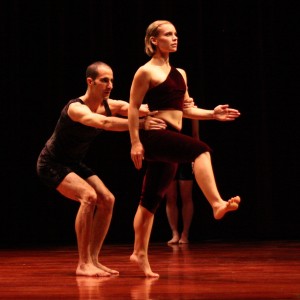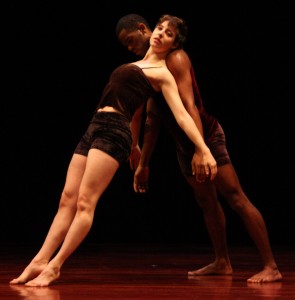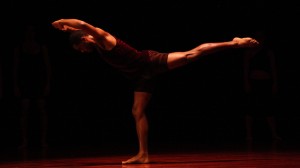Tribe
Reflections on Tribe with original cast members Madeline Hoak, Oren Barnoy, Rebecca Chaleff, and Corey L. Wright.
There was only one performance of Tribe and usually after so many hours of rehearsal it doesn’t seem like much of a pay off. You want to share the finished product with thousands of people, shout it from rooftops, tell the world you made art! But when I think back on it, rather than feeling disappointed or unfulfilled, it exists as a sacred moment dancers, musicians, and audience shared for one evening. Throughout the whole creation process the relationships between this family on stage was clear to me and the movement was always charged with the story.
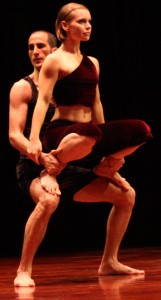 Of course there were moments of rote memorization and repetition to achieve technical perfection. (It would not be a DGDC work if it did not push the human limits of balance and speed.) These obstacles were approached by the cast in character: I remember a strong sense of community as we supported each other through the work’s development. We performed to live music, which is simply a joy. There is a certain energy that passes between dancer and audience during a show; adding live accompaniment increases that exchange ten fold. The vibrations are tangible. I have clear memories of holding a tableau for long amounts of time while Daniel adjusted the most minute details crafting the shapes and connections between the cast. It was tedious in the moment, but those tiny decisions were the molecules that grew into a beautiful beast rich in intention and powerful in story.
Of course there were moments of rote memorization and repetition to achieve technical perfection. (It would not be a DGDC work if it did not push the human limits of balance and speed.) These obstacles were approached by the cast in character: I remember a strong sense of community as we supported each other through the work’s development. We performed to live music, which is simply a joy. There is a certain energy that passes between dancer and audience during a show; adding live accompaniment increases that exchange ten fold. The vibrations are tangible. I have clear memories of holding a tableau for long amounts of time while Daniel adjusted the most minute details crafting the shapes and connections between the cast. It was tedious in the moment, but those tiny decisions were the molecules that grew into a beautiful beast rich in intention and powerful in story.
Tribe is a dance about family. Which ostensibly means it’s nearly about every emotion one can experience. I remember the feeling of brotherhood as Danny and I began to dance. Was the duet about creation? I am not sure but I do know that it was about integrity. And that integrity persisted throughout the entire dance with the whole tribe. It is a dance about being there for one another. Sharing each others’ weight demonstrated this. We needed each other literally on stage as well as metaphorically. Tribe is a dance I miss very much but it lives in me and I can take it with me and share it with new and old tribe members.
Dancing Tribe meant being part of a ritual. Rehearsing Tribe meant taking the subway to Battery Park several days a week. It meant negotiating the traffic and the pedestrians and the footpath across the highway. It meant confronting the tip of the island, reconsidering the horizon across the river, the vanishing point beyond my ken.
Rehearsing Tribe meant entering the Museum of Jewish Heritage. It meant entering a history that was my own at the same time that it belonged to everyone. It meant confronting those that shared this history with me, and those that tried to exclude me from it. Entering the Museum meant entering the ritual space of another temporality. As a dancer, I strove to embody the liveness of this history of ash and breath. But as a dancer incorporated within another framework of ritual practices, I also strove to find my place within the artifacts, memories, and affective remains collected within that space.
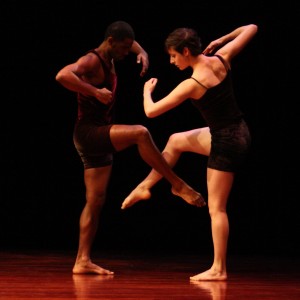 In Tribe, we clutched our hands in fists and moved our bodies within a cramped proximity. In syncopated rhythms, we stretched our hands upwards. In dissociated rhythms, we curled our arms back in. We moved like boomerangs away from our group, always daring to go farther, always daring to return. We felt the tensions of community as we developed our own rituals. We stretched in silence, counted phrases that our bodies sought to understand. We swung our arms around the feet that moved too quickly: our bodies tried to catch up with us as we tried to find each other.
In Tribe, we clutched our hands in fists and moved our bodies within a cramped proximity. In syncopated rhythms, we stretched our hands upwards. In dissociated rhythms, we curled our arms back in. We moved like boomerangs away from our group, always daring to go farther, always daring to return. We felt the tensions of community as we developed our own rituals. We stretched in silence, counted phrases that our bodies sought to understand. We swung our arms around the feet that moved too quickly: our bodies tried to catch up with us as we tried to find each other.
Tribe was the first dance in which Danny choreographed a solo for me. I remember that this solo had difficult balances, extended lines, and turns I struggled to stop in time. But I also remember the quality of the air around my body as I danced, and I remember the way my fingers felt as they sculpted and were sculpted by this space. I remember the gaze of my peers (my tribe) supporting me from the upstage space as the audience watched from their seats. I felt suspended. I was between the presence of the audience and the presence of my tribe. And I was between the present-ness of each of these groups. When I danced for all of these people, when was I dancing? In whose ritual was I participating? Or was I forming my own?
When you look at the word “tribe” it means family. Dynasty. Band. Nation. And in it’s own microcosmic way, working on Tribe delivered on its namesake.
Daniel likes to build pieces in phrases and segments. He does it both with the dancer and without the dancer. There were moments when we’d be standing there doing what he was saying and other times we’d all take the stage while he became Picasso and used our bodies as his gesticulating paint by way of “Follow the Leader” or an intricate piece-by-piece breakdown. Either way, we were all connected by a central theme of togetherness. It’s quite interesting because the hieroglyphic polish that is innately present throughout Tribe tells a story of not only building but building together…much like Daniel built the piece on us and furthermore, for us.
 The piece came from Daniel’s desire to personify a small part of history of an impactful group of people. At first — even though I was participating in the piece — I thought I was only meant to observe and tell the story. As the process continued a sense of self emerged and I united my heart with that group of people and, in turn, became a part of their tribe…even if for that moment. I was meant to be the story. I realized that we are all human. We all have a story. We are not unlike one another no matter what our differences are. It made me think further that I should not want to be colorblind. Ever. I should rather see color, rather, and appreciate it and embrace it and discuss the differences that may exist surrounding the people I am around.
The piece came from Daniel’s desire to personify a small part of history of an impactful group of people. At first — even though I was participating in the piece — I thought I was only meant to observe and tell the story. As the process continued a sense of self emerged and I united my heart with that group of people and, in turn, became a part of their tribe…even if for that moment. I was meant to be the story. I realized that we are all human. We all have a story. We are not unlike one another no matter what our differences are. It made me think further that I should not want to be colorblind. Ever. I should rather see color, rather, and appreciate it and embrace it and discuss the differences that may exist surrounding the people I am around.
Just like I would with an Uncle or Cousin. Brother or Sister. Friend or neighbor.
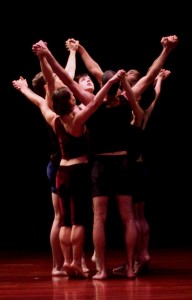 There’s much to be appreciated and uncovered. Tribe helped me to see that I have unrivaled permission to do so.
There’s much to be appreciated and uncovered. Tribe helped me to see that I have unrivaled permission to do so.
Choreography: Daniel Gwirtzman
Dancers: Oren Barnoy, Rebecca Chaleff, Madeline Hoak, Michael Novak, Maki Somekawa, Corey Wright and Daniel Gwirtzman
Composers: Shawn Baltazor, Roxy Coss
Costumes: Levi Okunov, Daniel Gwirtzman
Lighting: Stephen Petrilli
Photography: Gretchen Handloser
Venue: Museum of Jewish Heritage, New York City
Date of Premiere: October 21, 2009
WATCH ALL OF TRIBE ON DVD
A free gift with your $100 tax-deductible contribution.
Two Easy Ways
1. Send a check to the Company or use PaylPal. Email us at info@gwirtzmandance.org for more information.
2. Make a contribution of $100 to DGDC at NYCharities.org
BUY TICKETS TO THE ORACLE AT BAM FISHER: MAY 30-JUNE 1, 2014
